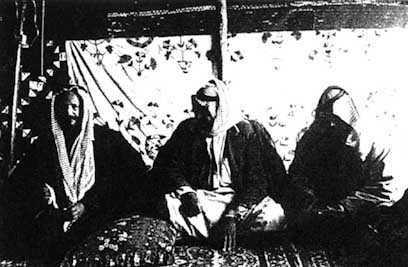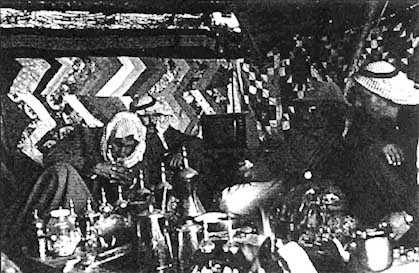1.1. Project background and present situation
1.2. Activities carried out
Bedouins are proud of grazing life and settlement never attracted them as long as their herds were fed and happy......The tribes are the nations and the rangelands are the states.
(A. Masri 1991)
- General overview
Project GCP/SYR/003/ITA is a rangeland and wildlife management project for the rehabilitation of marginal lands and the establishment and conservation of wildlife in the Syrian Steppe, which started in February 1996 with an overall duration of three years. The project is financed by the Government of Italy and is being executed by FAO and the Directorate of Al-Badia of the Ministry of Agriculture and Agrarian Reform (MAAR). The project area covers some 130,000 ha in one of the driest parts of Syria, with a mean annual rainfall of less than 200mm. It is divided into four sub-areas: Talila Wildlife Reserve, Arak, Mumbateh and Abassiya. This is part of a vast arid ecosystem named Al-Badia which covers approximately 55% of the Syrian territory. The project is located in the city of Palmyra within the building of the Directorate of Al-Badia. The international staff includes a CTA, a rangeland specialist, and a wildlife expert, while the national personnel is formed by a National project director, wildlife specialist, a rangeland counterpart and a technician, 4 extensionists (2 men and 2 women) and a national extension consultant.
The immediate objectives presented in the project document are: "to help national institutions to develop appropriate techniques for a sustainable use of the grazing land" and "to establish an integrated model for the use and maintenance of an area grazed by wild and domestic animals". The long term objectives of the project also foresee " to enhance human resources and communication abilities, data analysis and planning capacities of national officers for the development of improved techniques and new national regulation for the use of communal grazing lands".
The ultimate beneficiaries of the project are the livestock operators of the area, namely Bedouins households and tribes organised by the Peasant Union, a syndicate supported by the Government, in three local cooperatives for sheep raising: Arak, Mumbateh and Abassiya (see map 2). Another group of beneficiaries are the camel herders also organised under a cooperative. The cooperatives are in charge of range and sheep improvement but at the moment they mainly dedicate to provide supplementary feeding for sheep to their members. At the moment over three thousand members are inscribed in local cooperatives but the number of rangeland users is much higher than the people officially inscribed.
The grazing period varies according to the rainfall regime but in general it occurs during February - May. Nevertheless, animals are in Al-Badia also in the period included from November to January but they depend on supplementary feed (introduced for the first time during the drought of 1958-59), and normally provided by the Cooperatives to their members.
Since early 70s the Government issued law and acts to protect rangeland natural resources, especially by prohibiting cultivation in Al-Badia. Furthermore in 1991 Al-Talila Wildlife reserve was established to rehabilitate habitats, protect wild animals and to generate income to local communities through eco-tourism since the Palmyra area already attracts tourists with its historical and archaeological features.
Al-Badia Rangeland Sheep Directorate, the national counterpart agency, is implementing Government policy by:
- establishing 82 lamb fattening cooperatives;- reducing pressure on range;
- establishing 28 range and sheep improvement centres covering about 75,000 ha which are used for: seed collection; grazing by government sheep flocks; grazing by neighbours communities flocks; improvement of milk, meat and wool production; distribution of improved rams; establishing nurseries for the production of shrub seedlings; maintaining 170 wells.
- Activities and challenges: seeking the social sustainability of the project.
As mentioned earlier the project focuses on two major objectives: the improvement of range management and the establishment of a wildlife reserve. The main problem the project has to face is the deterioration of Al-Badia rangelands due to:
- destruction of vegetation cover by ploughing the land;
- early and overgrazing by an increasing sheep population;
- fuel collection through cutting and uprooting of fodder shrubs as source of firewood;
- off-road driving of vehicles that has destructive effect on vegetation and soils;
- increased stocking around boreholes and other sources of water.
The main activities being carried out to accomplish project objectives are:
- Range rehabilitation and management: improvement of range sites; planting shrubs; range reseeding; seed planting; data collection and monitoring of reseeding techniques and resided areas; surveys of soils, topography and vegetation; preparation of a range management plan; promotion of the use of alternative energy sources such as solar energy and solar stoves.- Wildlife reserve: reserve management plan; reintroduction of wild animals (gazelles and oryx); improvement offences; controlled grazing by camels in the reserve; feasibility studies on eco-tourism activities to be initiated; wildlife management through: monitoring of the animals; provision of water and supplementary feed; control of the fencing.
According to the tripartite review mission undertaken in October 1997 the project has already achieved successful results from the technical point of view. This is also due to the fact that the project has carefully considered socio-economic aspects (several studies have been carried out), promoting culturally appropriate technologies, and fostering the active participation of range resources users in several occasions.
Nevertheless, as underlined by the report of the tripartite review, in the project document the design of the social component was extremely weak if compered with the impact that rehabilitation measures will have on traditional grazing habits and to the need for collaborative management mechanisms involving all stakeholders for implementing sustainable management plans. Several range management specialists and ecologists indicate that the main social factors affecting the rangeland stability have been: inappropriate agricultural practices, the introduction of gasoline engines (water trucks, pick-up trucks, pumps and plough tractors) as well as the lack of consideration for the traditional tribal based rangeland management model, the so called Hema system. The latter is a delicate issue which will became evident once the range rehabilitation process supported by the project is completed, and the range management scheme implemented. This will also involve a clear definition of the land tenure system and the establishment of consultative decision making procedures, enabling the social sustainability of technical measures by involving and benefiting local people.
To take care of different social aspects the project is dealing with, since 1996 an extension unit was created and a strong Participatory Rural Appraisal (PRA) component is being implemented. Two PRA workshops were held (March and September 1997) to develop skills in PRA for applied field and extension work. Furthermore, a national consultancy was undertaken to identify the extension needs of Bedouin women. The PRA work contributed to:
- define a methodological framework to interact with the ultimate beneficiaries
- specifying main target groups of the project
- identify preliminary activities to be carried out
- identify extension needs both of men and women
- initiate community awareness
- identify activities addressed to women
- agree upon collaborative activities
- improve the ability of the extension staff to communicate with the target groups
Nevertheless PRA is a process, it is not an just an extractive means of gathering information. It is developed according to project needs to improve participation and to reach strategic agreements with the target groups. Presently, relevant socio-economic data as well as extension needs assessment of target population is being complemented and systematised. It will provide valuable elements to orient the overall strategy of the project as well as for further specifying extension and communication activities according to Bedouin needs. It also offers legitimacy for the project to claim for alternative rangeland management measures and presents to decision makers, cooperatives and households a possibility to establish a collaborative framework and procedures for participatory planning. Presently, the project is involved in the challenging task of establishing grazing committees to enhance participation and undertake collaborative activities. Furthermore, another important activity the project is initiating is the establishment of an extension programme for women.
The tripartite review recommended to strengthen the social component and the extension activities by formulating a communication strategy and workplan for the project in order to ensure that the intended beneficiaries "feel that they are stakeholders". This recommendation has been the starting point for the present mission.
- Mission framework and results
The mission was undertaken to build up a communication strategy within the context of the overall extension component and workplan actually being formulated to support project objectives and activities. To such extent, accurate analysis of the PRA assessment of stakeholders and project extension needs, as well as concrete opportunities and constraints to develop and implement the communication component have been carried out. The result has been the design of extension and communication activities, to reach awareness about project objectives and activities both at community, local, and national level, to support information, education and training processes and to enhance people's participation. Nevertheless, the consultant feels that further activities should be undertaken to validate mission outcomes at community level, to collect complementary data (especially regarding information flow among herders, presence of traditional opinion leaders, the use of mass media and the visual perception especially of women) and to carry out specific training on communication planning and participatory message design for the extension staff. Furthermore special attention should be also given to train the extension staff in low-cost media, radio and video production methodologies.
- Methodology and activities implemented
The terms of reference of the mission included the following tasks:
- assessment of main communication needs of the different target audiences of the project;
- preparation of a communication strategy up to the end of the project;
- identification of the most appropriate type of visual aids for modules aimed at Bedouin women;
- recommending simple techniques for producing educational materials;
- identification of production facilities in Syria;
- recommending guidelines for video series;
(Detailed Terms of Reference are presented in annex 1)
Due to the enormous amount of data already available within the project and the time constraints, the consultant concentrated on in-project assessment and planning activities such as:
- Intensive work with the CTA, the staff of the extension unit and the national extension consultant:presentations of communication for development concepts and methodology and of the assessment and planning activities for the extension/communication component (see document in annex 4);- PRA data analysis;
- Thematic brainstorming sessions;
- Questionnaire to assess staff tasks, skills and expectations (see annex 5).
- Field meeting with Camel herders for the establishment of a grazing committee;
- Interview of technical staff and local people;
- Interviews with the director of the Directorate of Extension, Ministry of Agriculture and Agrarian Reform and the Executive Producer to identify an institutional framework for collaboration and production facilities.
Finally, an early draft of mission recommendations was prepared, discussed and agreed upon with the project CTA before leaving Palmyra.

